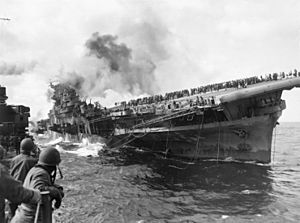Offensive (military) facts for kids
An offensive is a type of military operation where one side actively attacks or advances against an enemy. You might also hear it called an attack, an advance, or even an invasion. Offensives can happen on land, at sea, or in the air.
The main goal of an offensive is usually to fight the enemy in a battle. Sometimes, an offensive is used to make the enemy retreat and avoid a fight altogether. It's like when a team in a game decides to go on the attack to score points or push the other team back.
Contents
What is an Offensive?
An offensive is a planned military action. It is designed to gain an advantage over an opponent. This could mean taking control of land, destroying enemy forces, or achieving a specific goal. It's the opposite of a defense, where forces try to hold their ground.
Types of Offensives
Offensives can be different sizes and have different goals. The two main types are tactical and strategic.
Tactical Offensives
A tactical offensive is usually a smaller operation. It has a very specific and limited goal. For example, a tactical offensive might aim to:
- Capture a specific bridge.
- Take over a small stronghold or building.
- Rescue a group of people.
These operations often involve smaller groups of soldiers. Sometimes, Special forces are used for these precise tasks. The goal is usually achieved quickly.
Strategic Offensives
A strategic offensive is much larger. It involves many more soldiers and resources. These offensives have big, long-term goals. They aim to change the overall situation of a war. Examples of strategic goals include:
- Taking control of a large area of land.
- Destroying a large part of the enemy's army.
- Forcing the enemy to surrender.
Strategic offensives can last for a long time. They require careful planning and a lot of supplies.
Why Launch an Offensive?
Military leaders decide to launch an offensive for many reasons:
- To gain ground: To take control of important areas or resources.
- To destroy enemy forces: To weaken the enemy's ability to fight.
- To break a stalemate: To move the conflict forward when neither side is winning.
- To surprise the enemy: To catch the opponent off guard and gain an advantage.
- To protect allies: To help friendly forces or countries that are in danger.
Offensives are a key part of how wars are fought. They are often risky but can lead to big changes in a conflict.
See also
 In Spanish: Defensiva y ofensiva para niños
In Spanish: Defensiva y ofensiva para niños


